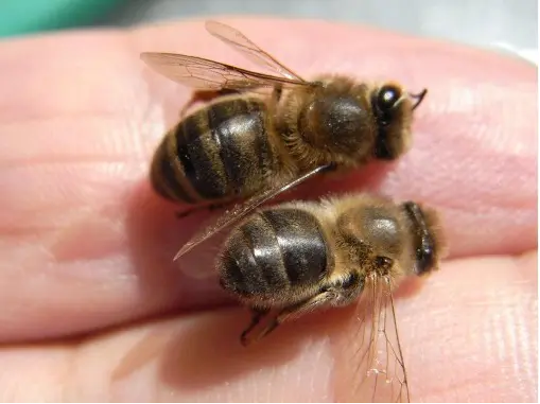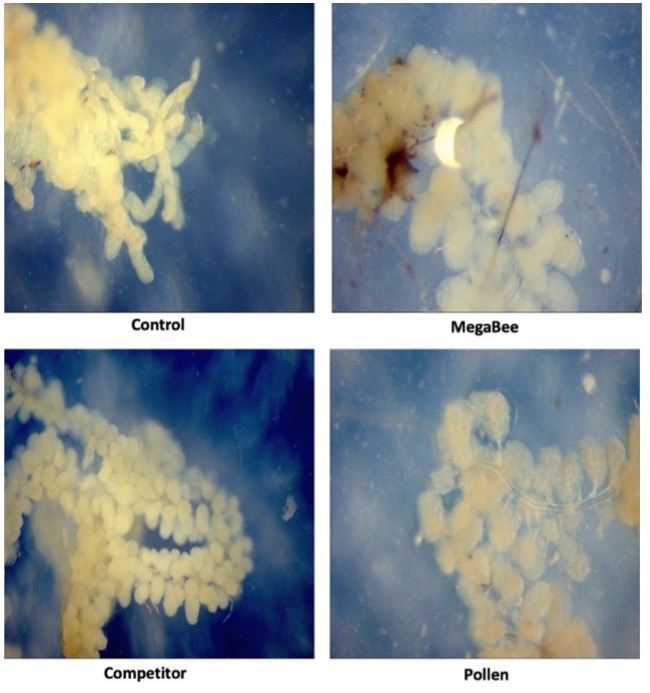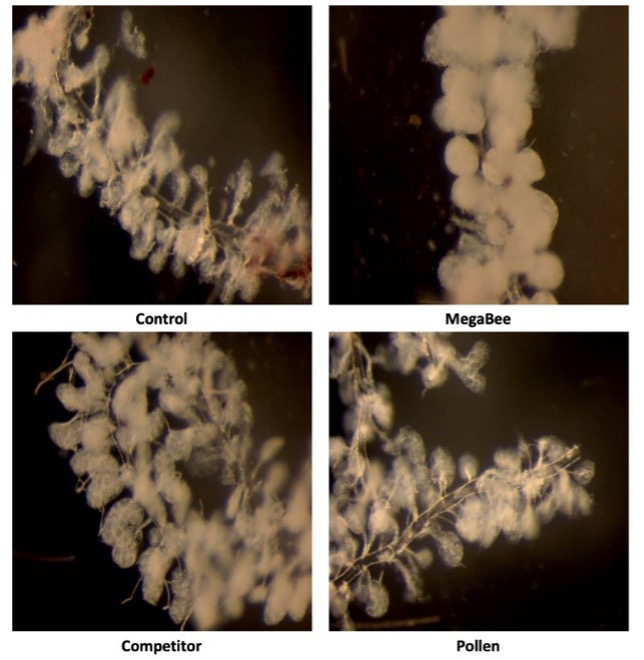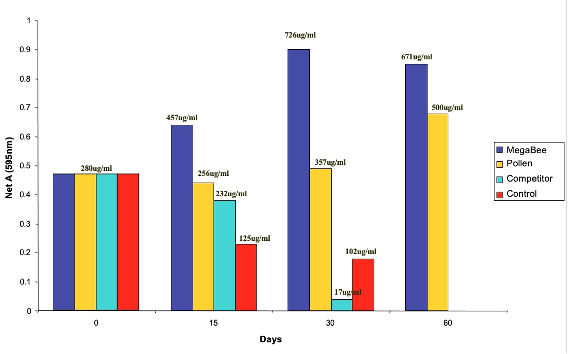In general, protein-rich diets can be used to promote hive development in spring and prolong the generation of winter bees during autumn. In addition, the use of high-protein nutritional supplements in regions where there is no variety of pollen sources or in times of shortage will help to prevent problems arising from malnutrition.
This is the case with MegaBee, which helps colonies in critical periods of stress or development, thanks to its unique composition and small particle size.
In the short term, the colony will attempt to maintain brood by first using stored bee bread and then using its own body reserves. In addition, in a desperate attempt to feed and rebalance the population, cannibalisation of larvae, initially the youngest, will occur and egg-laying by the queen will cease.1
A correct protein supply is necessary for the development of the colony, both individually and collectively. For example, in young bees it favours the maturation of the musculature involved in flight, the development of the hypopharyngeal glands (HP) and the ovaries2, which will have implications for the productivity of the colony and its reproductive capacity. Also, different indicators related to social (glucose oxidase activity) and individual bee immunity (amount of body fat) seem to depend on protein nutrition.3 In fact, a varied diet, with access to different quality pollens, is related to a better immune response4, lower mortality to pathogens such as Nosema ceranae5 and higher resistance to pesticides.6
It should be noted that the body of an adult bee contains 66-74% protein (taking into account only dry matter)7, so we may see smaller bees, with shorter abdomens than wings, due to lack of body reserves.8

An important part of the body protein is stored in the form of vitellogenin, a glycolipoprotein essential for multiple social, reproductive and immunological functions within the colony. This protein is incorporated into the hypopharyngeal glands and used in the production of royal jelly by the nurses, serving as food for the larvae.9 Vitellogenin production depends on the nutritional status of the bees and responds positively to the concentration of amino acids present in the haemolymph.10
Several studies with MegaBee showed a positive effect on the amount of protein present in the haemolymph and the development of hypopharyngeal glands (discussed later in this article).
In fact, the development of the hypopharyngeal glands in nurse bees is affected by many factors, including the quantity and quality of pollen or pollen substitutes they receive, so assessing the size of the glands is considered a good nutritional indicator.11
The key is in the hypopharyngeal glands…
The hypopharyngeal glands (HP glands) are a pair of structures located bilaterally on the head of the bee, between the eyes and the brain. They play a key role in the secretion of the protein fraction of royal jelly and worker jelly, and thus in the diet of the larvae, queen and worker bees in the colony.
At around 5-10 days of life, coinciding with the brood suckling activity of the young bees, the glands reach their maximum size and secretory capacity. At this time, under a microscope, they resemble a cluster of grapes, each grape representing an “acinus”. As the workers age and take on other roles within the colony, the glands decrease in size and their function becomes focused on breaking down the sugars in the nectar. Thus, the evolution of the HP glands correlates with the age of the bees and their role within the colony.12
The quantity and quality of protein that bees receive through their diet has been found to affect the size of the HP glands and can be used as an indicator of their nutritional status.13 The constant supply of protein ensures colony growth by allowing the nurse bees to provide protein to the larvae and the different bee castes. Because when there is enough royal jelly to feed the larvae… the nurse bees start to feed the other castes as well, including the foragers! By prolonging the life expectancy of each caste, an overlapping of generations is created, making the colony stronger and more resilient.
On the other hand, in malnourished colonies, brood development is reduced and workers’ protein nutrition is limited, shortening the time they perform tasks within the hive and initiating foraging earlier, resulting in reduced longevity.14
The following study compared the effect of different diets on HP gland development in 100 neonate bees, monitored under laboratory conditions for 4 weeks and divided into 4 groups.
All groups received a diet based on water and a sugar syrup. The control group received no protein, while the other groups received, in addition to sugars, a protein diet based on MegaBee (group called “Megabee”), another pollen substitute (group called “Competitor”) or pollen (group called “Pollen”).
The evolution of the hypopharyngeal glands of the different groups throughout the study can be seen in the following sequence of images:



Additionally, in the same study, the protein concentration in the haemolymph was regularly monitored in the four groups of bees to see if there was a correlation between bioavailable protein and its transformation at the glandular level:

Again, MegaBee showed surprising results with even higher levels than the pollen-fed group.
Subsequently, another in vitro study by DeGrandi-Hoffman et al. (2010)2 on newly emerged bees for 11 days evaluated the effect of diet on protein concentration and acini size of hypopharyngeal gland acini in three groups of bees: the sugar syrup-fed control (no protein), the pollen-fed control and the MegaBee-fed control. The results showed that both protein levels and acini size were similar in the pollen-fed and MegaBee-fed groups.
In summary, using a protein supplement such as MegaBee is essential for maintaining hive health and productivity, especially during critical periods of development or stress. Research shows that MegaBee not only helps prevent malnutrition, but also improves hypopharyngeal gland development, ensuring greater longevity and functionality of nurse bees. With improved protein nutrition, the bees can provide high quality royal jelly to larvae and other castes, strengthening the colony and making it more resistant to diseases and pesticides.
Want to know more about MegaBee? Follow us here !
References:
Schmickl T., Crailsheim K. (2002) How honeybees (Apis mellifera L.) change their broodcare behavior in response to non-foraging conditions and poor pollen conditions, Behav. Ecol. Sociobiol. 51, 415–425.
Brodschneider, R. and Crailsheim, K. (2010). Nutrition and health in honey bees. Apidologie, 278-294.
Alaux C., Ducloz F., Crauser D., Le Conte Y. (2010) Diet effects on honeybee immunocompetence, Biol. Lett., DOI:10.1098/rsbl.2009.0986.
Alaux C, Ducloz F, Crauser D, Le Conte Y (2010). Diet effects on honeybee immunocompetence. Biol. Lett, 6:562-565.
Di Pasquale G, Salignon M, Le Conte Y et al. (2013). Influence of pollen nutrition on honey bee health: do pollen quality and diversity matter? PLOS ONE, 8:e72016.
Barascou, L. et al. (2021). POllen nutrition fosters honeybee tolerance to pesticides. R. Soc. Open Sci. 8: 210818. https://doi.org/10.1098/rsos.210818
Hrassnigg N., Crailsheim K. (2005) Differences in drone and worker physiology in honeybees (Apis mellifera L.), Apidologie 36, 255–277.
Gonell, F., Gómez-Pajuelo, A. (2018). Buenas prácticas en sanidad y alimentación de las colmenas.
Amdam GV, Norberg K, Hagen A, Omholt SW (2003). Social exploitation of vitellogenin. Proc Natl Acad Sci USA 100:1799–1802.
Amdam, G.V., Fennern, E., Havukainen, H. (2012). Vitellogenin in Honey Bee Behavior and Lifespan. In: Galizia, C., Eisenhardt, D., Giurfa, M. (eds) Honeybee Neurobiology and Behavior. Springer, Dordrecht. https://doi.org/10.1007/978-94-007-2099-2_2
Corby-Harris, V., Snyder, L.A. (2018). Measuring Hypopharyngeal Gland Acinus Size in Honey Bee (Apis mellifera) Workers. J. Vis. Exp. (139), e58261, doi:10.3791/58261
Corby-Harris, V., Snyder, L.A. (2018). Measuring Hypopharyngeal Gland Acinus Size in Honey Bee (Apis mellifera) Workers. J. Vis. Exp. (139), e58261, doi:10.3791/58261
DeGrandi-Hoffman, G., Chen, Y., Huang, E., Huang, M. H. (2010). The effect of diet on protein concentration, hypopharyngeal gland development and virus load in worker honey bees (Apis mellifera L.). Journal of Insect Physiology. 56 (9), 1184-1191.
Toth, A.L., Kantarovich, S., Meisel, A.F., Robinson, G.E., 2005. Nutritional status influences socially regulated foraging ontogeny in honey bees. Journal of Experimental Biology 208, 4641–4649.
MGB-06-EN-N01-07/24
 by Véto-pharma
by Véto-pharma  by Véto-pharma
by Véto-pharma